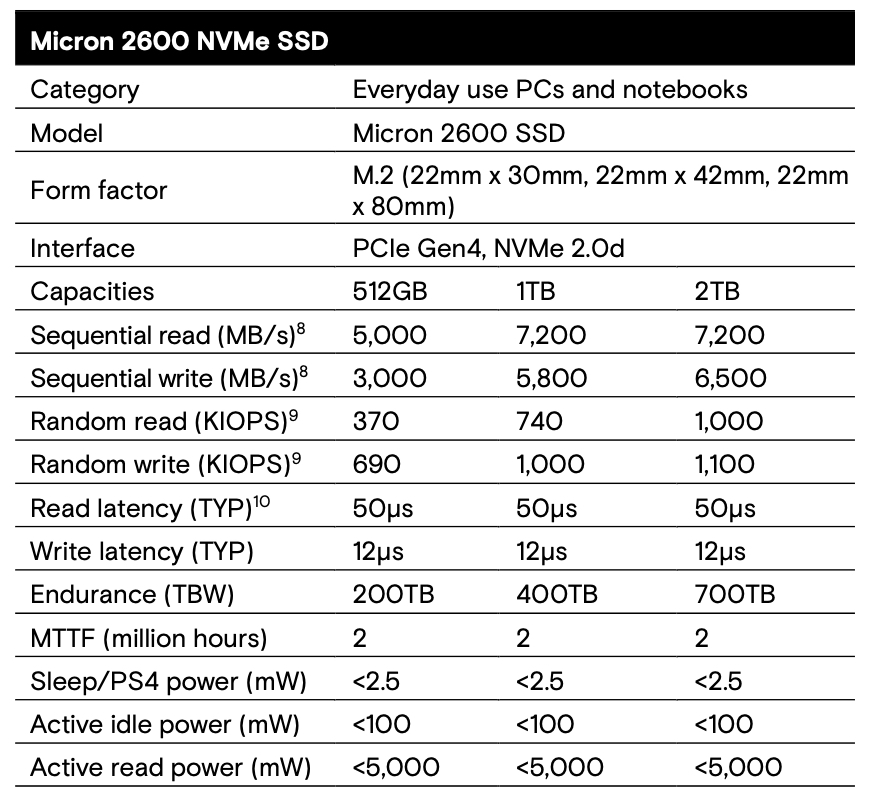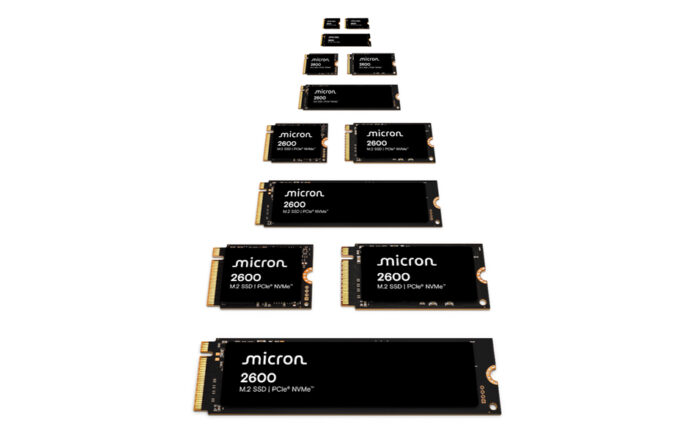The new 2600 client QLC SSD from Micron dynamically optimizes its cache to get QLC flash writing like TLC.
NAND has four basic formats for the number of bits in a cell: SLC with one, MLC with two, TLC with three, and QLC with four. Higher cell bit counts reduce cost but degrade write performance and endurance. The 2600’s Adaptive Write Technology (AWT) provides TLC-class write performance by having a top-level SLC cache for fresh incoming writes and a second tier TLC cache for use when the SLC cache is full. When both SLC and TLC mode areas are full, AWT migrates data from those areas to QLC mode when the SSD is idle, even for a short amount of time. As this process continues, AWT continues to migrate data from the SLC and TLC mode caches, folding that data into QLC mode. AWT also resizes the SLC and TLC regions to ensure the advertised capacity is available. This, Micron claims, achieves up to 63 percent faster sequential write and 49 percent faster random write speeds than competing value QLC and TLC SSDs.

Mark Montierth, CVP and GM of Micron’s Mobile and Client business unit, stated: “The Micron 2600 QLC SSD achieves superior performance compared to competitive value TLC drives … This Micron innovation milestone allows for broader commercial adoption of QLC NAND.”
The 2600 is a DRAM-less SSD with a Phison PS5029-E29T four-channel controller. It uses a 2 Tb die built from Micron’s 276-layer (G9) 3D NAND and has a six-plane architecture, with an NVMe PCIe Gen 4×4 interface. Micron says it offers “the fastest NAND I/O rate now shipping in a client SSD” and “up to four times faster sequential write speeds while continuously writing up to 800 GB of data to a 2 TB SSD.” Micron claims it offers better sequential and random performance compared to other DRAM-less TLC and QLC SSDs, and “easily surpasses competitor QLC and value TLC SSDs” in speed.
It has 512 GB, 1 TB, and 2 TB capacities, and its random and sequential performance and endurance numbers all increase with capacity:

Micron produced an earlier gumstick QLC drive, the 2500, in April 2024, with the same capacity points but built with earlier, 232-layer 3D NAND. At the 2 TB level, its random read and write IOPS were both 1 million and its sequential bandwidth was 7.1 GBps read and 6 GBps write. The 2600’s 1 million random read IOPS, 1.1 million random write IOPS, 7.2 GBPs sequential read, and 6.5 GBps million sequential write numbers are not that much better, with just 7.7 percent faster sequential write speed for example. It would appear that AWT provides a marginal gain for the 2600 compared to the 2500. The size of the SLC caches in the 2500 and 2600 is unknown, and a smaller SLC cache could negatively affect write performance.
Endurance is improved rather more, though, with the 2500’s 2 TB capacity point endurance of 600 TB written eclipsed by the 2 TB 2600’s 700 TB written, a 17 percent increase.
A Micron AWT technical brief provides a comprehensive explanation of how AWT works and how the SLC, TLC, and QLC region boundaries are dynamically changed as the AWT processes take place.
The 2600 with AWT is in qualification with Micron’s OEM customers and not all resulting 2600-based SSDs will necessarily use AWT – Micron is providing 2600 versions without it.
Bootnote
SSD speed comparisons are based on currently in-production, commonly available 2 TB QLC and value TLC NAND client SSDs from the top five competitive suppliers of OEM SSDs by revenue (using 1 TB where the supplier does not offer 2 TB), excluding consoles and Apple products, as per Forward Insights analyst report, “SSD Supplier Status Q1/25.” Performance comparisons are based on publicly available data sheet information.








